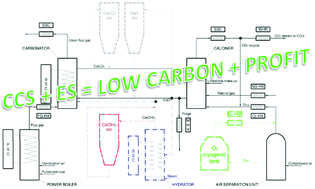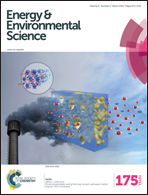Calcium looping with inherent energy storage for decarbonisation of coal-fired power plant†
Abstract
Implementation of carbon capture and storage, nuclear power stations and wide utilisation of renewable energy sources have been identified as capable of reducing around 42% of the energy sector’s cumulative CO2 emissions between 2009 and 2050. In scenarios assuming high shares of renewable energy sources in the energy portfolio, energy storage technologies and the remaining power generating assets would be required to flexibly balance energy supply and demand. With nuclear power plants operating at base load, this task would be handled by flexible fossil fuel power plants with CO2 capture. However, mature CO2 capture systems were shown to impose high efficiency penalties (8–12.5% points) and are better suited for base-load operation. An emerging calcium looping process, which has also been considered for energy storage, has been found to offer lower efficiency penalties (5–8% points). This study presents a concept of the calcium looping process with inherent energy storage for decarbonisation of the coal-fired power plant. Analysis has revealed that the possible routes for energy storage in this process include CaO/CaCO3 solids storage, CaO/Ca(OH)2 solids storage and cryogenic O2 storage systems. Comparison of the CaO/CaCO3 storage and cryogenic O2 storage systems revealed that implementation of the latter would result in higher turndown of the entire system and would offer higher energy density. Also, the hydration reaction was found to improve the energy density of the CaO/CaCO3 energy storage system by 57.4%, from 307.2 kWth h m−3 to 483.6 kWth h m−3. Economic evaluation of the proposed concepts revealed that application of the cryogenic O2 storage system in the calcium looping CO2 capture process has the potential to increase the profitability of the integrated system, even over the reference coal-fired power plant without CO2 capture.


 Please wait while we load your content...
Please wait while we load your content...